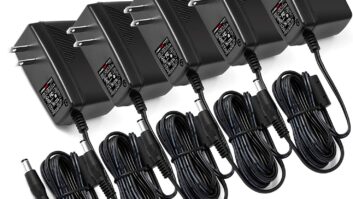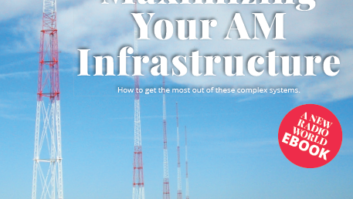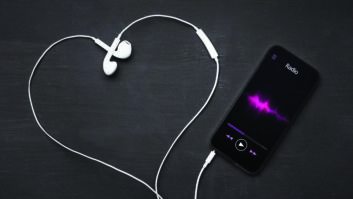This article summarizes comments that were filed in a noise floor technical inquiry conducted by the Technological Advisory Council of the FCC�s Office of Engineering and Technology. The TAC had asked users of public communications spectrum, including broadcasters, for input to help it set goals for a radio spectrum noise study.
The author is president of Kintronic Labs Inc.; he was invited to prepare this summary for a presentation to the IEEE Broadcast Technology Society. This paper summarizes responses and concludes with the author�s recommendations. A copy also was filed with the commission.
�
The subject of this paper concerns the licensed and unlicensed users of electromagnetic spectrum and the growing concern over the degradation in achieving reliable (1) analog and HD AM and FM as well as DTV broadcast reception, (2) wireless communications service, (3) amateur radio reception and (4) broadband internet service as a result of a decreasing signal-to-noise ratio due to an apparent increase in the noise floor in the DC to >1 GHz frequency band.
�
It is for this reason that the Federal Communications Commission Technical Advisory Council under the direction of the Office of Engineering and Technology issued a Technical Inquiry under ET Docket No. 16-191 in order to request spectral noise measured data from any and all licensed and unlicensed users of electromagnetic spectrum and to respond to a list of questions that included the following:
�
Is there a noise floor problem? Where does the problem exist? Spectrally? Spatially? Temporally? Is there quantitative evidence of the overall increase in the total integrated noise floor across various segments of the radio frequency spectrum?�How should a noise study be performed?
�
The responses to these questions will serve to establish a basis from which the TAC could develop a set of achievable goals to present to the chairman of the FCC to act on in an effort to improve the reliability of broadcast and communication services that are being adversely affected by an increasing noise environment. The responsibility for this noise study will be the responsibility of the TAC Spectrum and Receiver Performance working group that is currently co-chaired by Dr. Greg Lapin, who represents the American Radio Relay League, and Lynn Claudy, senior vice president for technology at the National Association of Broadcasters.
�
GENERAL RESPONSE SUMMARY TO THE TAC TI
According to a summary report prepared by Geoff Mendenhall, consultant to Gates Air Corp. and who is currently serving on the TAC Spectrum and Receiver Performance working group, a total of 93 submissions were received at the FCC Electronic Filing System, some of which were duplicates. Responses were received from 73 different people or organizations. The breakdown on responders was as follows:
- 23 companies/industry organizations
- 39 RF professionals (broadcast and wireless)
- 31 licensed radio amateurs
- 9 responders did not reply to the questions asked
- The four [bullets] below illustrate the most widely used services that are affected by the increasing noise floor.
- Cellphone and broadband internet service
- AM/FM/DTV reception
- Police, fire and emergency responder communications
- Amateur radio two-way communications
- Individuals and companies representing each of these sectors of public communications submitted responses to the TAC TI.
HIGHLIGHTS OF SPECIFIC RESPONDERS
[The sections below summarize the filed comments of the named organizations.]
I. ARRL
The FCC classification of noise emitters is as follows:
- Intentional emitters, such as broadcast stations or mobile telecom cell sites.
- Unintentional emitters, such as high-efficiency fluorescent and light emitting diode (LED) lights, computers, plasma TVs and switching power supplies
- Incidental emitters, such as overhead power lines and motors
- Man-made noise sources fall under one of these three categories and together attribute to the overall spectral noise floor with the highest levels being in the large, metropolitan urban areas and the lowest levels being in the rural areas. The ARRL response noted that Section 15.5 of the FCC rules calls for operators of an interference-causing RF device to cease operating the device if interference to authorized services develops.
- Operators should be aware of this rule and seek FCC enforcement with supporting documented evidence.
In addition, Chris Imlay, the author of the ARRL response, referred to an IEEE Recommended Practice on the resolution of power line noise complaints (P1987) that is being developed by the IEEE Electromagnetic Compatibility Society Standards Development and Education Committee. This document should be distributed to all operators of broadcast and wireless communications services when available.
�
II. Society of Broadcast Engineers
On May 26, 1999 the FCC requested that the TAC study the noise floor and propose new approaches to spectrum management based on emerging and future technologies. The commission has since 1999 skipped the urgent step of evaluating the RF environment before repeatedly and constantly making allocation decisions. The time is now to proceed with a well-planned comprehensive nationwide noise floor study.
�
The commercially available range of RF devices has expanded significantly resulting in a previously limited range of 30 MHz to 3 GHz as per the current FCC Part 15 and 18 rules to an expanded range up to 70 GHz; hence a review and updating of the current rules relating to noise interference is in order.
�
The IEEE is in the process of revising Std. 473, a standard on site surveys, which does include test methodology for the measurement of signals and noise at test sites and at locations of equipment. This should be made available to TAC when completed.
�
SBE recommendations to the TAC:
- Increased cooperation is needed between manufacturers of Part 15 devices and users of radio spectrum to identify noise sources and take appropriate remedial action.
- Radiated emission limits below 30 MHz in the FCC Part 15 rules for unintentional emitters should be enacted. There are presently no radiated emission limits below 30 MHz for most unintentional emitters.
- Reduced Part 15 limits for LED lights should be enacted to be harmonized with the Part 18 lower limits for fluorescent bulbs.
- Better labeling on packaging for Part 18 fluorescent bulbs and ballasts to better inform consumers of potential interference to radio, TV and cellphone reception in the residential environment.
- Specific radiated and/or conducted emission limits for incidental emitters, such as motors or power lines, should be enacted.
- Conducted emission limits on pulse-width motor controllers used in appliances should be enacted.
- Substantially increase the visibility of enforcement in power line interference cases.
�
III. National Association of Broadcasters
The FCC was created to address the interference chaos that threatened to destroy nascent radio services in the early 20th century. The FCC has unfortunately relinquished this role to self-regulation of the manufacturers of consumer products with associated RF emissions, which clearly has led to deregulation of the noise floor contributors and a resulting increase in the noise floor.
�
The NAB pointed out that (1) FM HD injection was increased from �20 dBc to �10 dBc in some cases due to the need to overcome the ambient noise floor, and (2) numerous VHF DTV stations moved to the UHF band to avoid noise interference issues. These are examples of how the FCC has avoided attacking the real source of the problem, which is a rising noise floor.
�
NAB�s recommendations to the TAC:
- The FCC should review the general Part 15 emission limits to determine what improvements are necessary to protect licensed services and adopt strict and enforceable limits that will limit noise interference. As a minimum the commission should adopt and enforce a radiated emissions limit of 0.025 mV/m measured at a distance of 10 meters to protect AM radio operators.
- The FCC should reexamine Section 15.13 of its rules that states that manufacturers of incidental radiators should employ �good engineering practices to minimize the risk of harmful interference.�
- The NAB proposed the following harmful interference levels shown in Table 1 below.

�
�
IV. National Public Safety Telecommunications Council�
Public Law 110-140-DEC.19, 2007, Subtitle B, Lighting Energy Efficiency: Energy Independence and Security Act of 2007 established requirements for improvements in energy efficiency of lighting equipment, which set the transition from incandescent to high-efficiency fluorescent and LED lighting on a fast track. Section R404.1 of the 2012 International Energy Conservation Code requires that a minimum of 75 percent of lamps in permanently installed lighting fixtures should be high-efficiency lamps. High-efficiency lamp types include:
- Compact fluorescent lamps
- A T8 or smaller linear fluorescent lamp
- Any lamp meeting minimum efficiency requirements:
� � � � � �A. 60 lumens/watt for lamps over 40 watts
� � � � � �B. 50 lumens/watt for lamps over 15 watts, but no more than 40 watts
� � � � � �C. 40 lumens/watt for lamps rated at 15 watts or less
�
The NPSTC response included a list of noise interference to public safety communications examples among which are the following two examples:
1. Reported by the New York Department of Transportation: Multi-voltage ballasts for fluorescent lighting in a particular building resulted in noise in the VHF low band, loss of coverage, and garbled transmissions impacting portables, mobiles and base receivers within 50 yards of the building.
2. Industry Canada: Electronic ballasts for fluorescent lights in a nearby store produced 20�MHz wide broadband noise in the 800 MHz cellular band resulting in loss of coverage or dropped calls within 2 km of the store location.
�
V. State of California Governor�s Office of Emergency Services & Public Safety Communications
The response for the CalOES included the following statement: �During the last 20 years, and even more so over the last five years, we have encountered more and more interference from sources that were not causing interference prior to that time.� In their response they listed the following major sources of noise interference:
- Fluorescent lights
- LED lights
- Computers and embedded controllers
- Switching power supplies and battery chargers
- Industrial equipment
- Power tools
- Solar panel inverters
- Cable TV/internet distribution systems
- Power line communications and Broadband over Power Lines
- Electric automobiles
In response to the question as to what levels does the noise floor cause harmful interference to particular radio service, CalOES responded with the following levels shown in Table 2 below.
�
�

�
VI. CTIA Representing the U.S. Wireless Communications Industry
CTIA highlighted the following RF emitters as major sources of noise interference to the US wireless services:
�
A. Incidental radiators
� � � � � �a. Electric motors
� � � � � �b. Light dimmers
� � � � � �c. Switching power supplies
B. Unintentional radiators
� � � � � �a. High-efficiency lights
� � � � � �b. Computers
� � � � � �c. Garage door receivers
�
Commercial Mobile Radio Service is impacted by an increasing noise floor as follows:
- Reduction in carrier�s reliable service area
- Lost coverage for cell sites at the outer boundary of a carrier�s network
- More dropped calls traveling between cell sites
- Diminished voice quality
- Slower data transmission or lost data packets
- Considering the number of cell sites that are presently in operation in the USA, the cost to the service providers in reduced quality of service resulting from noise interference has to be a staggering amount.
VII. AT&T
AT&T has had marginal success in working with large manufacturers of industrial lighting to encourage the incorporation of noise filtering in the associated power modules. In the midst of our government�s drive toward the increase usage of high-efficiency lighting, manufacturers are motivated to disregard noise concerns due to the higher product cost of adding filter components.
�
AT&T is particularly concerned about the potential impact of noise on small cells sharing a support with LED lights. A single faulty power supply conducting noise through power lines can compromise their network service out to a distance of a half mile, which is a significantly large area.
Harmonics from unintentional radiators, i.e. FM broadcast transmitters, are the greatest noise source impacting AT&T Mobility Services. FM station interference can degrade the uplink signal in the 700�2300 MHz band within 2,000 feet of the station. Also data speeds in the 3�4 GHz range between a computer and other ancillary devices, such as a video display, create harmonics and noise products that interfere with cellphone service.
�
AT&T recommendations to TAC:
- Noise from incidental radiators could be mitigated through updated industry standards, better testing protocols for device manufacturers, and clarity in commission regulations for spurious emissions
- Improved testing at a wider frequency range up to 6 GHz would identify the potential for interference to commercial mobile and public safety licensees, avoiding the inefficient and piecemeal approach of identifying and mitigating noise after it occurs.
- The commission should create incentives for FM broadcasters to encourage the use of FM transmitter cabinets that are properly bonded and shielded in an effort to comply with mobile service providers� minimum receiver signal levels.
- Better and updated standards and specifically higher frequency standards for designing, constructing and testing incidental radiators would minimize noise from data busses and interfaces in computing devices.
�
VIII. National Electrical Manufacturers Association
The NEMA response made reference to two publications on the subject of manmade noise measurements in the United Kingdom and in the U.S. [The publications are Wagstaff & Merricks, �Manmade Noise Measurement Programme,� 2009; and Achatz & Dalke, �Man-made Noise Power Measurements at VHF and UHF Frequencies,� NTIA Report 02-390, US Department of Commerce, 2001.]
�
As a result the noise measurements were found to be in good agreement for the most part and resulted in the following recorded noise floor levels as shown in Table 3 below.
�

�
This data clearly shows that the Medium-Frequency AM band is significantly more affected by the noise floor than the VHF, UHF or mobile cellphone service bands. A reduction of 9�11 dB in the noise floor level is realized between the city and rural environments over the 300 kHz to 100MHz band.
�
SUMMARY AND CONCLUSIONS
There is a clear consensus from the great majority of the responders to the TAC technical inquiry that a noise floor study is not only needed, but is way overdue. Even though the measured evidence of noise interference was very scarce in the responses, the experiences of broadcasters, public safety communications service providers, amateur radio operators and mobile phone and internet service providers that specifically stated the reduction in service reliability that they have been experiencing in recent years on an increasing scale should be sufficient evidence to the TAC to prove that a thoroughly planned and implemented noise study with inputs from all parties concerned is definitely needed.
�
Furthermore in these times of natural disasters, war or terrorist activities, secure, clear wireless communications are of the utmost importance. The growing vulnerability of the internet to hackers has to be causing our government, military and the banking industry to consider other forms of communication that are more secure. We cannot afford to allow the producers of products with associated RF emissions in our limited electromagnetic spectrum to be proliferated without regulatory action. The matter of our understanding the noise floor versus frequency and what sources contribute to it is of great strategic importance to assure reliable and secure public communications for the safety of all citizens of the USA. The SBE response made reference to the following statement: �It would be impossible for the commission to engage in effective spectrum management until it develops a more complete understanding of the current state of the radio noise environment.� [FCC TAC, Second Meeting Report at 1, 9 (Oct 28, 1999).] This further substantiates the need for the noise floor study.
�
A version of this article originally appeared in Radio magazine sister publication Radio World.
�
�












